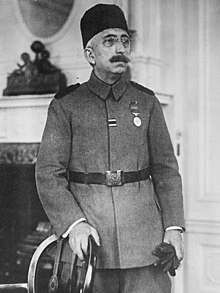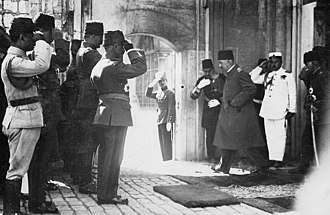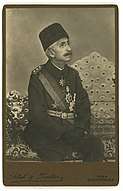Mehmed VI
Mehmed VI Vahideddin (Ottoman Turkish: محمد السادس Meḥmed-i sâdis, وحيد الدين Vahideddin, Turkish: Vahideddin or Altıncı Mehmet), also known as Şahbaba (meaning "Emperor-father") among Osmanoğlu family, (14 January 1861 – 16 May 1926) was the 36th and last Sultan of the Ottoman Empire, reigning from July 4, 1918 until November 1, 1922 when the Ottoman Empire dissolved after World War I and was replaced by the Republic of Turkey on 29 October 1923. The brother of Mehmed V, he became heir to the throne after the 1916 suicide of Abdülaziz's son Şehzade Yusuf Izzeddin as the eldest male member of the House of Osman. He acceded to the throne after the death of Mehmed V.[2] He was girded with the Sword of Osman on 4 July 1918, as the thirty-sixth padishah. His father was Sultan Abdulmejid I and mother was Gülüstü Hanım (1830 – 1865), an ethnic Abkhazian, daughter of Prince Tahir Bey Çaçba and his wife Afişe Lakerba, originally named Fatma Çaçba.[3] Mehmed stepped down when the Ottoman Sultanate was abolished in 1922, and the secular Republic of Turkey was created with Mustafa Kemal Atatürk as the first president.
| Mehmed VI | |
|---|---|
| Ottoman Caliph Amir al-Mu'minin Sultan of the Ottoman Empire Kayser-i Rûm Custodian of the Two Holy Mosques Khan | |
 | |
| 36th Ottoman Sultan (Emperor) | |
| Reign | 4 July 1918 – 1 November 1922 |
| Sword girding | 4 July 1918 |
| Predecessor | Mehmed V |
| Successor | Monarchy abolished |
| Grand Viziers | See list
|
| 28th Ottoman Caliph | |
| Reign | 4 July 1918 – 19 November 1922 |
| Predecessor | Mehmed V |
| Successor | Abdulmejid II |
| Head of the House of Osman (in exile) | |
| Pretence | 19 November 1922 – 16 May 1926 |
| Predecessor | Mehmed V |
| Successor | Abdulmejid II |
| Born | 14 January 1861 Dolmabahçe Palace, Istanbul, Ottoman Empire |
| Died | 16 May 1926 (aged 65) Sanremo, Kingdom of Italy |
| Burial | 3 July 1926 [1] |
| Consorts | Nazikeda Kadın Inşirah Hanım Müveddet Kadın Nevvare Hanım Nevzad Hanım |
| Issue | Fenire Sultan Ulviye Sultan Sabiha Sultan Şehzade Ertuğrul |
| Dynasty | Ottoman |
| Father | Abdulmejid I |
| Mother | Gülüstü Hanım (Biological mother) Şayeste Hanım (Adoptive mother) |
| Religion | Sunni Islam |
| Tughra |  |
Early life
Mehmed VI was born at the Dolmabahçe Palace, in Constantinople on 14 January 1861.[4][5] Mehmed's father died when Mehmed was only five months old, and Mehmed's mother died when he was four years old. He was raised and taught by his step-mother Şayeste Hanım, who trained himself by taking lessons from private teachers and attending some of the lessons given at Fatih Madrasa.[1] The prince had a rough time with his overbearing stepmother, and at the age of 16 he left his stepmother's mansion with the three servants who had been serving him since childhood.[6]
Throughout his childhood, his youth, and even during his middle age. He grew up with nannies, female servants, and tutors. During the thirty-three years of his brother Sultan Abdülhamid’s reign he lived. [7]
During his youth his closest friend was Abdulmejid II, the son of his uncle, Sultan Abdülaziz. But sadly in the years to come the two cousins became unyielding rivals. Before moving to the Feriye Palace the prince had lived briefly in the mansion in Çengelköy owned by Kemaleddin Efendi. [8]
During the reign of Sultan Abdul Hamid, Mehmed was considered to be the sultan’s closest brother. In the years to come, when the young prince ascended to the throne, this closeness would greatly influence his political attitudes, such as his intense dislike of the Young Turks and the Union and Progress Party, and his sympathy for the British. [9]
Education
As an orphan, Vahideddin Efendi had to educate himself. He took private lessons, he read a great deal, and he was interested in various subjects, including the arts, which was a tradition of the Ottoman family. He took courses in calligraphy and music and learned how to write in the naskh script and to play the kanun (a kind of zither). [6]
Then he became interested in Sufism, and unknown to the Palace he followed courses at the madrasa of Fatih on Islamic jurisprudence, Islamic theology, interpretation of the Quran, and the Hadiths, as well as in Arabic and Persian. He attended the dervish lodge of Ahmed Ziyaüddin Gümüşhanevi, located not far from the Sublime Porte, where Ömer Ziyaüddin of Dagestan was the spiritual leader, and he became a disciple of the Naqshbandi order. [10]
Reign
Mehmed succeeded to the throne after the death of his half-brother Mehmed V on 3 July 1918. [11]
The First World War was a disaster for the Ottoman Empire. British and allied forces had conquered Baghdad, Damascus, and Jerusalem during the war and most of the Ottoman Empire was divided amongst the European allies. At the San Remo conference of April 1920, the French were granted a mandate over Syria and the British were granted one over Palestine and Mesopotamia. On 10 August 1920, Mehmed's representatives signed the Treaty of Sèvres, which recognised the mandates and recognised Hejaz as an independent state.
The sultan requested the resignation of the Unionist government and assigned Ahmed Tevfik Pasha to form the government. In the speech of the opening of the new legislative year of the parliament, Wilson said that he applied for peace according to his principles, that he wanted peace in accordance with the honor and dignity of the state, that he believed that the precious places of the homeland were not occupied, and that the army would begin heroically. Mustafa Kemal Pasha, who sent a telegram to the Sultan, asked the government to establish Ahmed Izzet Pasha and make him a minister of Harbiye. The sultan assigned the task of forming the government to his son Ahmed Izzet Pasha.[1]
The new government, consisting of members of the Hürriyet and the Alliance Party, arrested the leaders of the Committee of Union and Progress, including one of the former grand vizier Said Halim Pasha. The trial of Boğazlıyan District Governor Kemal Bey was immediately concluded, and the death penalty was executed in Beyazıt Square when the sultan's fatwa was signed by the sultan.[1]
Meanwhile, the French General d'Esperey, who came to Istanbul, threatened to go to the palace with a battalion soldier and make what they wanted by burning the distractions of the sultan and his government. He called him to the embassy without visiting the Grand Vizier. Turkey put on a war unless undertaken harsh application of the decision would be heavily on the Ottoman Empire. The government, on the other hand, stated that the British could not give the twenty-three people they wanted to surrender. The French handed over a list of thirty-six people they wanted to arrest to the government.[1]
Turkish nationalists rejected the settlement by the Sultan's four signatories. A new government, the Turkish Grand National Assembly, under the leadership of Mustafa Kemal (Atatürk) was formed on 23 April 1920, in Ankara (then known as Angora). The new government denounced the rule of Mehmed VI and the command of Süleyman Şefik Pasha, who was in charge of the army commissioned to fight for the empire against the Turkish National Movement (the Kuvâ-i İnzibâtiyye); as a result, a temporary constitution was drafted.
On 22 July 1920, Şurayı Saltanat was gathered in Yıldız Palace to discuss the principles of the Treaty of Sèvres which was a peace treaty. The Sevres Agreement was signed on 10 August 1920. Since he had to resign two and a half-month later, Ferid Pasha founded the last delegation of Tevfik Pasha, the last delegation of the Ottoman Empire, on 2 October 1920. [12]
Exile and death
The Grand National Assembly of Turkey abolished the Sultanate on 1 November 1922, and Mehmed VI was expelled from Istanbul. One day before his departure, he had lunch with his daughter Ulviye Sultan and spent a night at her palace.[13] Leaving aboard the British warship Malaya on 17 November 1922, Mehmed spent that night in Cihannümâ Mansion. He took care not to buy valuable items and jewelry other than his personal belongings. Harington himself took the last Ottoman ruler from Yıldız Palace. Ten people in the sultan and his entourage were sent off early in the morning by an English battalion. He went into exile in Malta; Mehmed later lived on the Italian Riviera.[1]
On 19 November 1922, Mehmed's first cousin and heir Abdulmejid Efendi was elected caliph, becoming the new head of the Imperial House of Osman as Abdulmejid II before the Caliphate was abolished by the Turkish Grand National Assembly in 1924.
He sent a declaration to the Caliphate congress and protested the preparations made, declaring that he had never waived the right to reign and caliphate. The congress met on 13 May 1926. Mehmed died without the news of the congress meeting on 16 May 1926 in Sanremo, Italy. Her daughter Sabiha Sultan found money and foreclosed, so the coffin was taken to Syria and buried at the Tekkiye Mosque of Sultan Suleiman the Magnificent in Damascus.[14][1][15]
Character
Mehmed Vahdeddin had an optimistic and patient personality according to the testimony of his relatives and employees; He was a kind family man in his palace; outside, and especially at official ceremonies, he would stand cold, frowning and serious, and would not compliment anyone; he attached great importance to religious traditions; the palace didn't know the gossip and didn't like it being spoken alongside. Even in his informal conversations, he always attracted attention with seriousness. The sources in question also state that he was intelligent and quick-grasped, but he was under the influence of his entourage and especially those he believed in, that he had a very evident, unstable and stubborn temperament.[1]
Mehmed VI has dealt with advanced literature, music and calligraphy. His compositions were performed in the palace when he was on the throne. The lyrics of the songs he repeatedly composed while in Tâif envision the longing of the country and the pain of not getting the news that they have left behind. Sixty-three works belonging to him can be identified, but only forty works have notes. His poems, which can be an example to his poetry, are only the lyrics of his songs. He was also a good calligrapher.[1]
Gallery
 Departure of the former emperor Mehmed VI from Dolmabahçe Palace after the abolition of monarchy, 1922.
Departure of the former emperor Mehmed VI from Dolmabahçe Palace after the abolition of monarchy, 1922. Photograph of Mehmet VI by Sébah & Joaillier, c. 1920.
Photograph of Mehmet VI by Sébah & Joaillier, c. 1920. A portrait of Mehmed VI.
A portrait of Mehmed VI.
Family
Sultan Mehmed VI married five times:
- Abkhazian Nazikeda Kadın (née Fatma Emine Marşania, Sukhum, Abkhazia, 9 October 1866 – Maadi, Cairo, 4 April 1944 and buried there), married at Istanbul, Ortaköy, Ortakoy Palace on 8 June 1885, daughter of Prince Hasan Ali Bey Marşan by his wife Princess Fatma Horecan Hanım Aredba,[3] and had three children:
- Fenire Sultan (1888, Ortaköy Palace, Ortaköy, Istanbul, – 1888, Ortaköy Palace, Ortaköy, Istanbul);
- Fatma Ulviye Sultan (11 September 1892, Ortaköy Palace, Ortaköy, Istanbul, – 25 January 1967, İzmir and buried at Çengelköy, Üsküdar, Istanbul, first married to Damat Ismail Hakki Okday Beyefendi (Athens, 28 October 1881 – Istanbul, 11 October 1977) at the Kurucheshme Palace, Istanbul, on 10 August 1916, with issue; second marriage to Damat Ali Haidar Beyefendi (Göztepe, Istanbul, 20 September 1889 – Istanbul, 5 February 1962) at the Nişantaşı Palace, Nişantaşı, Pera (today Beyoğlu), on 1 November 1923, also with issue.
- Rukiye Sabiha Sultan (Ortaköy Palace, Ortaköy, Istanbul, 1 April 1894 – Istanbul, 26 August 1971), married to her cousin Şehzade Ömer Faruk (the Ortaköy Palace, Istanbul, 27/29 February 1898 – 28 March 1969/1971), son of Abdulmejid II, at the Yıldız Palace, Istanbul, on 29 April 1920 as his first wife, and had issue, three daughters including, Fatma Neslişah Sultan.
- Circassian (of the Ubykh tribe) Inşirah Hanım (née Seniye Voçibe, Batumi, 10 July 1887 – Cairo, 30 June 1930), married at Istanbul, Üsküdar, Çengelköy, Çengelköy Palace on 8 July 1905 and divorced on 7 November 1909, daughter of Zekeriya Aziz Bey Voçibe,[3] without issue.
- Abkhazian Müveddet Kadın (née Şadiye Çıhçı, Adapazarı, 12 October 1893 – Çengelköy Palace, Çengelköy, Üsküdar, Istanbul, 1951 and buried there), married at Istanbul, Üsküdar, Çengelköy, Çengelköy Palace on 25 April 1911, daughter of Kato Davut Bey Çıhcı by his wife Ayşe Hanım,[3] and had:
- Şehzade Mehmed Ertuğrul (Çengelköy Palace, Çengelköy, Üsküdar, Istanbul, 5 September 1912 – Cairo, 2 July 1944). No Issue.
- Albanian Nevzad Hanım (Istanbul, 2 March 1900 – 23 June 1992), married at Istanbul, Yıldız Palace on 1 September 1921, daughter of Şaban Efendi Bargu by his wife Hatice Hanım,[3] without issue.
- Abkhazian Nevvare Hanım (née Ayşe Çıhçı, Adapazarı, 4 May 1901 – 13 June 1992), married at Istanbul, Dolmabahçe Palace on 20 June 1918, daughter of Mustafa Bey Çıhcı by his wife Hafize Hanım Kap,[3] without issue.
See also
- Line of succession to the former Ottoman throne
References
- "MEHMED VI محمد (1861-1926) Son Osmanlı padişahı (1918-1922)". İslam Ansiklopedisi. Retrieved 19 April 2020.
- Freely, John, Inside the Seraglio, 1999, Chapter 16: The Year of Three Sultans.
- Harun Açba (2007). Kadın efendiler: 1839-1924. Profil. ISBN 978-9-759-96109-1.
- Chisholm, Hugh, ed. (1911), The Encyclopædia Britannica, 7,
Constantinople, the capital of the Turkish Empire
. - Britannica, Istanbul:When the Republic of Turkey was founded in 1923, the capital was moved to Ankara, and Constantinople was officially renamed Istanbul in 1930.
- Bardakçı 2017, p. 6.
- Bardakçı 2017, p. 4-5.
- Bardakçı 2017, p. 7.
- Bardakçı 2017, p. 8.
- Bardakçı 2017, p. 6-7.
- Sakaoğlu 2015, p. 488.
- Sakaoğlu 2015, p. 494.
- Sakaoğlu 2015, p. 497.
- Freely, John, Inside the Seraglio, published 1999, Chapter 19: The Gathering Place of the Jinns
- Sakaoğlu 2015, p. 498.
Sources
- Sakaoğlu, Necdet (2015). Bu Mülkün Sultanları. Alfa Yayıncılık. ISBN 978-6-051-71080-8.
- Bardakçı, Murat (2017). Neslishah: The Last Ottoman Princess. Oxford University Press. ISBN 978-9-774-16837-6.
Further reading
- Fromkin, David, 1989. A Peace to End All Peace: The Fall of the Ottoman Empire and the Creation of the Modern Middle East ISBN 0-8050-0857-8
External links
![]()
Mehmed VI House of Osman Born: 14 January 1861 Died: 16 May 1926 | ||
| Regnal titles | ||
|---|---|---|
| Preceded by Mehmed V |
Sultan of the Ottoman Empire 3 July 1918 – 1 November 1922 |
Sultanate abolished Succeeded by Mustafa Kemal Atatürk as President of Turkey |
| Sunni Islam titles | ||
| Preceded by Mehmed V |
Caliph of the Ottoman Caliphate 3 July 1918 – 19 November 1922 |
Succeeded by Abdulmejid II |
| Titles in pretence | ||
| Preceded by Sultanate abolished |
— TITULAR — Sultan of the Ottoman Empire 1 November 1922 – 19 November 1922 |
Abdulmejid II |
